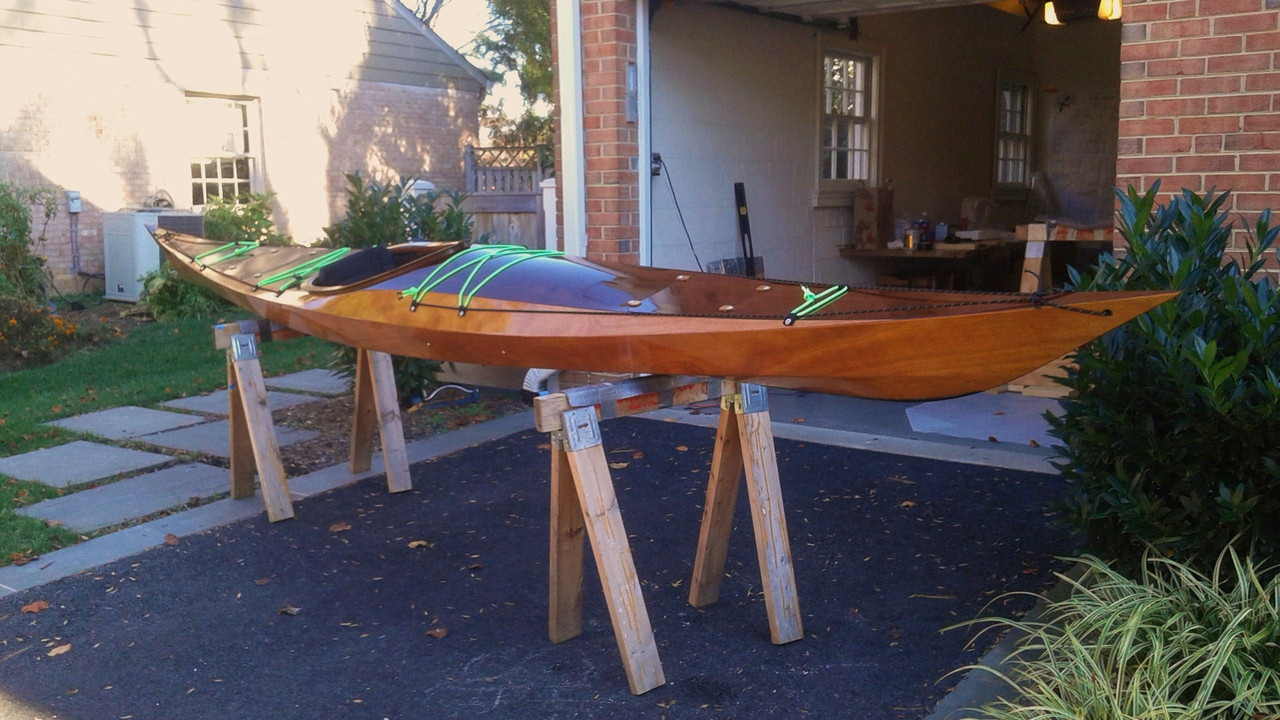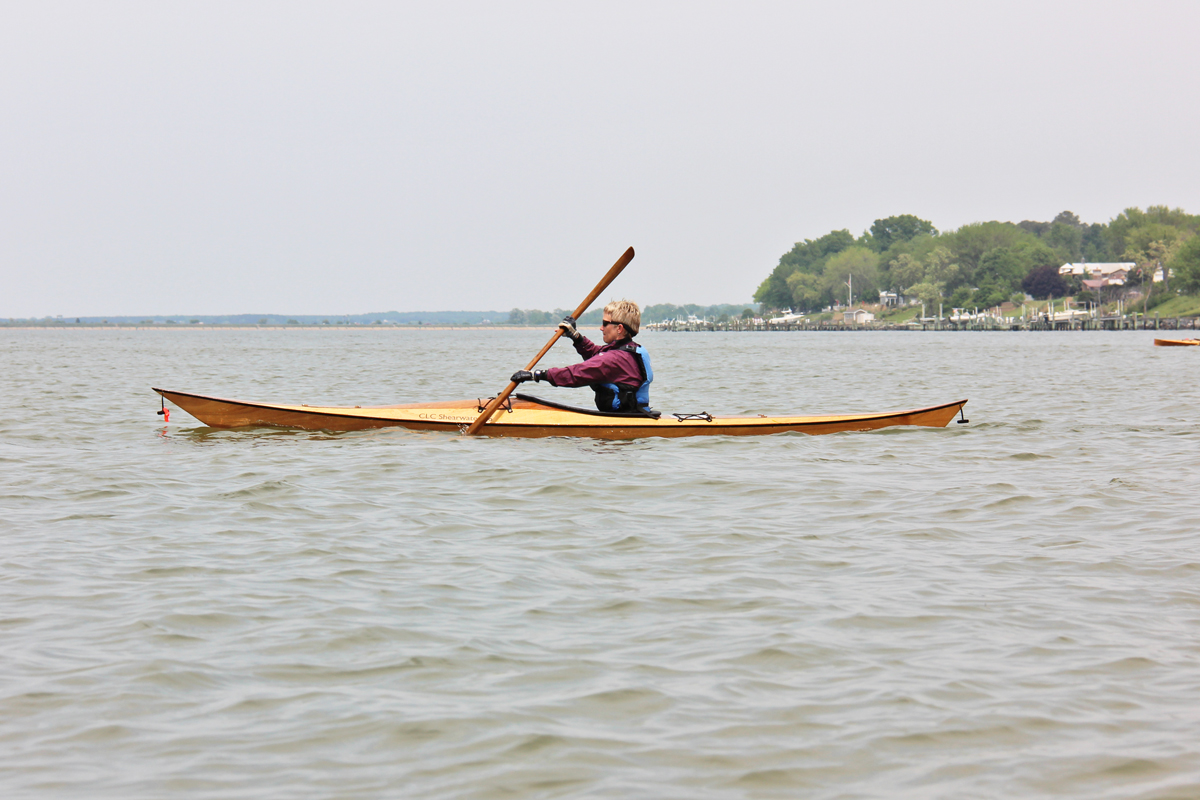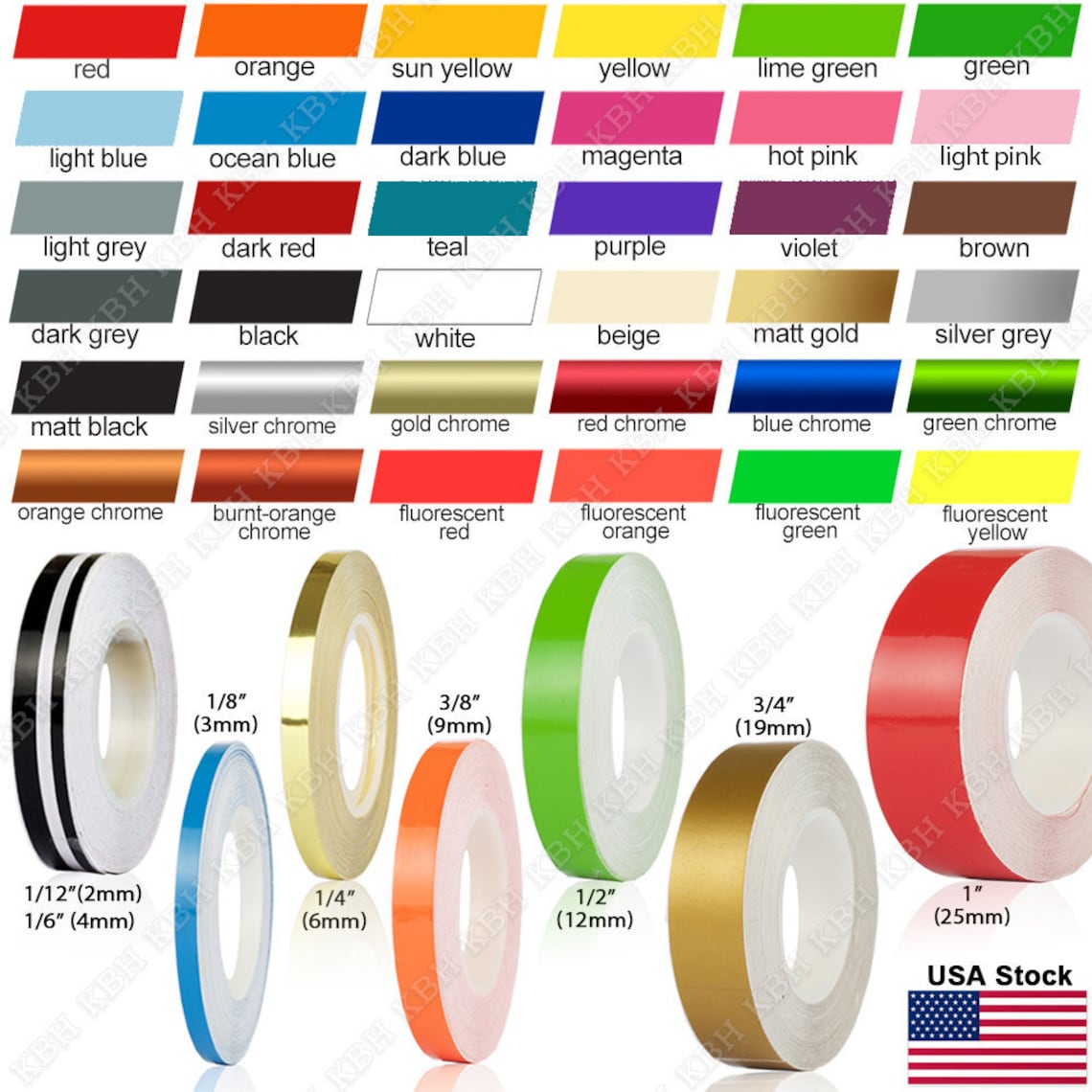Builders' Forum |
|
| ↓ Scroll to Last Comment ↓ | Forum Guidelines | Builders' Forum | |
So -- I've run across a snag with my Shearwater Sport.
Is a long story how I got to this point, but heres the short version. I put masking tape down (very evenly) below the sheer line prior to laying glass on the deck. I then cut the wetted out glass to this tape and removed the tape. However this left a small white line....
In trying to feather the deck to the hull this distinct line can be seen in places despite a lot of sanding. I even sanded through in one spot and am working on a repair in that area... In the interest in not making things even worse I have decided to not sand more and go through in other areas. The hull is fair and flat.
I'm thinking that I will add a 1/4" stripe about 1- 1/2" below the sheer line to hide this white line.
My question is ... how is this best achived? Some type of pin striping tape or painted on? Either way -- what is the best way to achieve this?
Yes -- this was discouraging to discover -- even worse to sand thu and need to make a repair. However, it is what it is and the boat will float regardles. Now I just need to make the mistake invisible....
Dave.
14 replies:
RE: How to do stripes?
Ok -- I'm going to try to post a link to a couple photos here to show the small white line I'm refering to.
Let's see if I can get this photo thing to work.
https://www.dropbox.com/s/sklcvvb63dk3aqn/IMG_5375.jpg?dl=0
https://www.dropbox.com/s/17fx058o47c7rol/IMG_5376.jpg?dl=0
https://www.dropbox.com/s/afm3xwzppsasmz5/IMG_5377.jpg?dl=0
You can see the small almost dotted white line in several places, but you might have to zoom in. Granted from 10-15 ft back it would be hard to see.
As I read your procedure, I realize I may have missed a step at the time. I merely cut the glass lightly and peeled off the tape. In a couple places I slightly squeeged the glass down after the tape removal, but I did not add more epoxy. At the time my though was to not mess around with the glass too much to cause it to fray -- that was very very frustrating on the three layers I did on the hull. It also caused a lot of sanding. That experience that promted me to look into a "better way to handle the glass without all the fraying edges -- which leads me to where I am now.
To be honest -- I'm learning a ton on this boat... however I do think that the manual for the Shearwater Sport, and the way the kit is designed is a bit dated. It would seem (from you tube and such) that newer techniques (often time savers and simplifiers) have been developed. Had CLC made this known to me at the time of the purchase, I may have selected a "newer" designed kit.
RE: How to do stripes?
Just trying to work out how to post photos on this site...

I think I got it to work...
This is the boat after all the fill coats on the deck glass, but prior to feathering in the overlap on the hull. I was pretty proud of it at this point.
Dave.
RE: How to do stripes?
Hi Dave,
i looked at your pictures and most recent post.
on your post, you did not miss a step and appear to have approached it just fine. the suggestion of adding some epoxy/squeegee and then sand was just a trick i learned after handling it like you did that made the process go a bit faster and easier.
what i can't tell from the picture is the line visible because you simply have not completed the 'feathering' sanding or is there something else going on. the particular step can be a PITA....to bring the two surfaces flush....but it's conceptually pretty straight forward.
did you try the denatured alcohol trick i suggested. if after feather sanding, if the line disapears when soaked with denatured alchohol (e.g., when wet)...then it is just a sanding issue....you just need to feather it some more (or add some epoxy and feather it if you need some more thickness) if when wet with denatured alcohol you can still see white dots then it is something in the glass itself.
that said, it does not look bad. the shearwaters are a pretty modern design within the CLC catalog.....so i don't think you are disadvantaged there.....
but to your point, what the manual says vs what you learn after some hands on experience can be a bit of a gap.
 while its not the sport, attached is a photo of my shearwater 17. the shearwaters are a really nice family of boats. you are going to be delighted when you finish it. they paddle most excellently.
while its not the sport, attached is a photo of my shearwater 17. the shearwaters are a really nice family of boats. you are going to be delighted when you finish it. they paddle most excellently.
h
RE: How to do stripes?
just saw your latest picture. i think it looks really good. i suspect it is just a sanding issue....and how you feather the second layer in. but looks very good in the picture.
RE: How to do stripes?
Thank you hspira ... I appreaciate the kind words.
As I think about it now-- I think you are probably right about the sanding issue and I think I have figured out where I went wrong. In the last photo I posted you can see there are two lines below the shear line. The highest one is where I cut the glass to the tape. the lower line was a second line of tape I added on one of subsequent applications of fill coat epoxy. At the time my thought had been to step down the epoxy to make feathering it easier. I did those coats in succession without sanding.
My theory here is that in peeling the tape I left small little bubbles on the seam/edge of the cut glass. Then without sanding I added more epoxy and "cast" these bubbles deep into the lay up. Yes, I could probably sand them out, but I'd risk more sand throu areas like I have already had to repair -- I'm not sure I can emotionally handle that. I was pretty dissappointed in myself when I sanded through the first time. Thankfully I have repaired that, and it seems almost invisible now (I should have took some photos) In any event, I'm not sure that sanding to that depth in the epoxy layup is worth the time/effort. Maybe one day I'll feel different, but I have a strong suspicion this will not be my last boat.
Thanks again for helping me worth thru this issue -- your boat looks awesome! I hope that one day mine looks as good!
I do have another question -- if you don't mind. I see on your boat you have the rub strip on the bow (I assume on the stern too.) I ordered this add on kit from CLC as well, but I'm curious if you installed it from new or retrofit it?
I'm asking as I'm unsure of the sequence when installed from new. The instructions indicated to sand away all varnishin the area the rubstrip will be installed... however it doesn't mention if its good practice to install it prior to varnishing? Any thoughts on that?
Dave.
RE: How to do stripes?
Sorry, I just realized I didn't really answer about the denatured alcohol suggestion -- yup I have wiped it down several times to get a view of what it would look like, but the white dotted line remains.
I have made my peace with it.
Dave.
RE: How to do stripes?
your explanation makes sense.
making peace with it is not a bad approach. the good news, as you point out, is you can simply decide at a later point to address it. for now, just finish and enjoy. i have done that several times ....boat initial-build-imperfections that i dealt with after a season or two.
on your question about rub strips. i installed them prior to varnishing. i think if you know you want them, its easier to do that way. if there is a problem or some sanding clean up, its all taken care of and then you only have to varnish once.
on the attached picture below, as an interesting evolution (and sort of related to the topic of feathering), after the rubstrip was applied, i went back and applied additional epoxy to bring the hull surface back up and flush with the level of the rubstrip (painted over in this example). so it has a totally smooth hull with an integrated rub-strip look vs something that looks like it was put on afterwards.

took a couple additional sessions....but was a cool little tweak.
RE: How to do stripes?
A sheer stripe on varnished stitch-and-glue kayaks is really common. Honestly, I prefer the look!

This is one of our demo models. And that sheer stripe, folks, is...black electrical tape!
Holds up really well. I think the stripe on that one is ten years old now.
For more intricate striping, we always go to the auto parts store and buy the vinyl striping sold for cars. It's rugged and looks like it was painted on.

RE: How to do stripes?
John,
Thanks for the tip. That's just what I was going to do for my WR18 (use auto striping tape) and it's good to have confirmation that it holds up in salt water.
Dave,
I've been reading along and letting Howard do all the answering since he was covering it better than I could, but I do have one question for you. The way you describe things it sounds as if you put down the tape, wet out the glass, then cut the glass and peeled the tape. Was the epoxy still wet?
On my boats I wait until the glass cures "green" - not tacky and feels like stiff leather.
Then I peel the glass up off the tape. It stops peeling naturally at the edge of the tape where it's bonded to the wood.

Next I nick the glass at one end with a razor and start pulling on it. It mostly tears along the edge of the tape. If it wanders, just a little nick will set it right again.

Then remove the tape, wait a day or two to let the glass fully cure and knock the edge off with some #220 paper. I use a ROS, but for a first boat Howard's idea of a sanding block is much safer.

Here's the line all sanded before the weave is filled. It goes right through the duck graphic, good luck finding it.
The really important thing is waiting for the green cure before tearing, not cutting, the glass and then waiting for the full cure before sanding the line to feather it. That's why I was wondering if maybe you tried to cut the glass while it was still wet. That would explain why you had all the trouble even though everything you described sounded as if you were doing it right.
I know this won't help on this boat, but for the next one (there's always a next one0 you'll be able to get perfection with no trouble.
Laszlo
RE: How to do stripes?
just want to confirm that i use the same approach laszlo described and i think it was important to highlight the timing.
the only minor difference for me is i do 'score' the leathery epoxy just inside the tape line with a box cutter as i pull the 'leathery' stuff off to minimize fibres pulling through the leathery consistency epoxy on the other side.
but all the rest of your timing i follow as well. would create a bit of a mess to start 'feathering' uncured epoxy.
h
RE: How to do stripes?
So -- thanks for the tip on auto striping. I actually picked some up and tried a small stretch of it, and am pleased to report that it will nicely cover the "learning opportunity" (aka - mistake.) So that's my current plan. I may play around with how wide a stripe I would like, but that's for later in the project.
As for the timing of the cut/tear at the tape line. I did wait about 2hrs and I had my shop about 71-72F. If my memory serves me, I recall the epoxy was pliable but was a bit sticky yet. In that regard I possibly didn't wait long enough, however I still think my main error was that I didn't sand and then applied two more coats of epoxy the following day.
On a side note -- all this waiting around for epoxy to cure... how on earth do they build a whole boat at CLC in a week class? I've been at this for 6 weeks now.
Thanks again for all the advice -- despite some moments when I was frustrated with my result, this boat building experience has been amazing! This forum has been very helpful and is a great resource.
As for a "another boat"... I have a Petrel Play kit on order, just trying to work out shipping it to Canada. Maybe that one will be perfect?
RE: How to do stripes?
Dave, which Petrel Play are you building, S&G or Strip? I built the S&G six years ago and absolutely love it. It is a rather difficult S&G build because the deck has a lot of curves/bends which are hard to stitch and glass. It is a monster in waves but may be a bit small for bigger paddlers. I'd suggest adding a skeg. I installed one as a retrofit so I went with the KayakSport kit. Building from scratch, I'd go with the kit that CLC sells for the PP (https://www.clcboats.com/shop/kit_options/stitch-and-glue-petrel-play/1693.html).



RE: How to do stripes?
Hi Mark
I have the Petrel Play SG on order. Your boat looks fantastic.
As for the complexity of the build -- I think I'm ready. I didn't have much trouble stitching the Shearwater Sport, nor getting the glass in it... I'd be willing to take on a new challenge that way.
I also have a skeg kit for it -- but the one you installed looks very good, very clean.
I do have a question about the size of paddler... I'm 6' tall and 215lbs. So I'd be near the top of the recommended paddler weight. When you say large paddlers might not like it, do you think I'd be in that category?
Again, your boat looks incredible -- I can only hope mine turn out as well.
Dave.













RE: How to do stripes?
» Submitted by hspira - Tue, 10/27/20 » 12:00 PM
hi dave,
any way you can post a picture. i have recently been using https://postimages.org/ as a place to upload pictures and then link/show them here.
i have performed the procedure you are referring to more than a dozen times so i am a bit curious about the link that you say won't go away.
some details on how i have approached this:.
once i have cut the deck glass at the tape line and before 'feathering it in' i put the boat up on its side and put a coat of epoxy (using a two inch foam brush) right down the middle of that line and then go over it with a squegee. this fills the gap between the different surface heights and begins the feathering process so that when i further 'feather' it with sanding....i have created a bit more space (thickness) to work with.
when i do my sanding to 'feather' i almost always work by hand with a relatively small, stiff sanding block. takes a bit longer but easier to control....that said, a sandthrough on this task is not unheard of....so i would not call that alarming.
also have you also wiped the line down with denatured alcohol to see if you will see the line you are concerned about? i just have not had the experience where the process you described created such an optical problem to have to consider a pinstripe over it.
anyway, a pictures worth a thousand words.
best
h